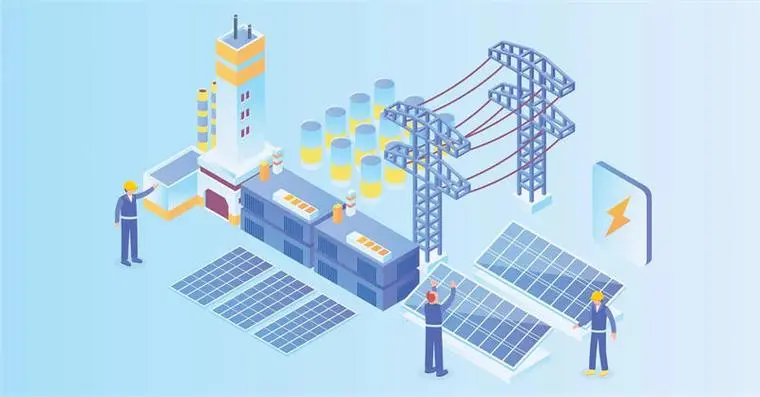In today’s world, energy demand has reached new heights in both developing and developed countries. For decades, electricity has been delivered from traditional power plants to end-users via the grid. However, these power plants are now facing issues such as overloading and aging infrastructure. Meanwhile, access to the grid in remote areas remains limited. Mini-grids and microgrids have emerged as solutions to these problems, providing electricity to remote regions. So, what is the difference between the two? This article will explore their roles and differences in detail.
What is a Mini-Grid?
Before comparing the two, let’s first understand their basic concepts. A mini-grid refers to an independent, localized power network that provides electricity to a specific community, village, or region. It often relies on renewable energy sources like solar and wind, sometimes combined with energy storage systems to ensure standalone power supply, especially in remote areas that are not connected to the national grid. Mini-grids can operate independently or connect to the main grid to enhance power supply stability. In emerging energy economies like rural communities in Africa, mini-grids have successfully improved education, commerce, and overall quality of life.
What is a Microgrid?
A microgrid is a localized power system capable of switching between being connected to the main grid and operating in “island mode.” Its primary feature is its flexible control and smart management capabilities. A microgrid can operate in tandem with the main grid or disconnect and run independently when the main grid fails, ensuring reliable power supply during outages. Microgrids not only interact with the central grid but can also support it when needed. Like mini-grids, microgrids can operate entirely independently if required.
What are Their Roles?
Both mini-grids and microgrids aim to improve the accessibility and reliability of electricity. Mini-grids are typically used in remote areas to provide electricity to communities that cannot connect to the national grid. Microgrids, on the other hand, focus more on enhancing the flexibility and reliability of energy systems, ensuring that critical loads remain operational during grid outages. Additionally, microgrids can relieve stress on the central grid during peak demand periods by providing additional support.
Their Similarities
- Renewable Energy Usage: Both mini-grids and microgrids can generate power using renewable sources like solar and wind, often equipped with energy storage systems to ensure stable power supply.
- Independent Operation: Both systems can operate independently of the main grid, making them especially useful in remote or specialized environments.
Differences from Traditional Grids
Traditional power grids are centralized energy systems, typically powered by large-scale power plants and delivering electricity through vast transmission and distribution networks to users. While they can serve large populations, they are heavily reliant on centralized power sources. As aging infrastructure and high-load issues arise, traditional grids can become less reliable.
In contrast, mini-grids and microgrids are decentralized and flexible. Mini-grids primarily serve remote areas, operating independently from the main grid to provide electricity to regions not covered by the traditional grid. Microgrids, on the other hand, can switch between grid-connected and island mode, providing enhanced reliability during outages. They also have smart management systems that allow them to coordinate with the central grid.
Differences Between Mini-Grids and Microgrids
Although mini-grids and microgrids are localized energy systems, they have several distinct differences:
- Mini-grids are typically larger in scale and can serve entire communities or regions. They are often designed to operate independently in remote areas but can also connect to the main grid. Mini-grids can integrate multiple energy sources, including solar, wind, and fossil fuels, making them ideal for areas with insufficient or no grid coverage.
- Microgrids are usually smaller, designed for specific applications like single facilities or campuses. Microgrids have the capacity to interact with the main grid, switching seamlessly to island mode during outages. They focus on integrating renewable energy and energy storage systems. Microgrids are commonly used in universities, military bases, hospitals, and industrial facilities, enhancing the resilience and reliability of energy supply. microgrids can contribute to the grid’s stability by participating in demand response programs through a VPP, helping to prevent grid overload.
How to Build a Mini-Grid or Microgrid?
Building a mini-grid or microgrid involves several key steps:
- Needs Assessment and Planning: First, assess energy demand to determine the required capacity and coverage. This includes analyzing energy consumption patterns and determining the best power solutions for the community or facility.
- Energy Source Selection: Choose appropriate energy sources, such as solar, wind, hydro, or fossil fuels. For renewable systems, consider a paired energy storage system to ensure stable power supply.
- System Design and Engineering: Plan the system design based on energy needs and source selection, including the layout of power generation equipment, storage systems, and distribution networks. The system must be flexible enough to switch between standalone and grid-connected operation.
- Equipment Procurement and Installation: Purchase equipment that meets the design requirements, including generation devices, inverters, storage units, and control systems. Ensure proper installation and testing by professionals to meet safety standards. You can also contact PKNERGY for integrated BESS solutions to reduce commissioning time.
- Control System Integration: A smart control system is critical when building a microgrid or mini-grid. It monitors and regulates energy production and distribution, ensuring efficient operation and interaction with the main grid.
- Testing and Commissioning: After installation, conduct comprehensive system tests to ensure compatibility and reliability between components. Test both island mode and grid-connected mode to ensure the system operates correctly under different scenarios.
- Operation and Maintenance: Once online, regular maintenance and monitoring are essential for efficient operation. This includes maintenance of generation equipment, health checks on storage systems, and control system updates and optimization.
Conclusion
The decentralized nature of mini-grids and microgrids offers significant advantages in integrating renewable energy sources, making better use of solar, wind, and other distributed energy resources. By reducing dependence on fossil fuels, they improve the flexibility and reliability of energy systems, making them a crucial solution for both rural electrification and modern smart grid applications.
Save Money, Protect Environment
PKNERGY helps you reduce your energy bills for your home solar energy storage, store your solar energy for use anytime- at night or during an outage.





